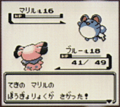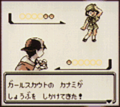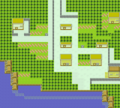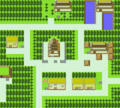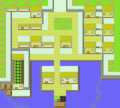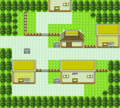Pokémon Gold and Silver beta

|
This article is incomplete. Please feel free to edit this article to add missing information and complete it. Reason: Add missing information and media, like that found on other sites, such as The Cutting Room Floor wiki; expand some information and add missing references to reliable sources, when applicable |

|
The contents of this article have been suggested to be split into different articles. Please discuss it on the talk page for this article. |
The development cycle of Pokémon Gold and Silver, released in 1999 in Japan and 2000 elsewhere, is probably the most discussed and researched of all releases in the core series games during the history of the franchise. A relatively broad amount of official material in combination with later investigations reveal a lot of details about incomplete and unreleased elements. Several aspects from the development stages are proof of the over two-year period in which Game Freak undertook with the sequels to the Generation I games.
Pre-release
First mention of Pocket Monsters 2
In 1997, Nintendo announced the first details about the then-next generation of Pocket Monsters games, to be titled Pocket Monsters 2: Gold & Silver (Japanese: ポケットモンスター2 金・銀). The games were intended to be released at the end of the year for the original Game Boy, while supporting the Super Game Boy enhancements that the Generation I games have.
One of the many notable additions promised was a skateboard that could be used in addition to the Bicycle of the previous games, and which would allow the player to travel to "unusual places". Though this never appeared in the released game, other things announced, such as the time system with its real-time clock, as well as 100 new Pokémon, including new evolutions of old Pokémon, and new TMs and HMs containing new moves, were included. The communication abilities of the games were also to be improved, and backwards compatibility with the Generation I games was also announced.
A 1997 edition of MicroGroup Game Review showcased some Pokémon and character designs that were later scrapped.
Sprites of Donphan, Ampharos, Slowking, and Ho-Oh were also released, using the Super Game Boy palettes.
Concept art of Silver, Ledyba and the opening cutscene of the games was also published.
Four of the "new" Pokémon that would be included in Pocket Monsters 2.
New Pokémon in the anime
The anime also provided early peeks at the new Pokémon. Ho-Oh, the eventual game mascot of Pokémon Gold, appeared in the first episode. Later, Togepi hatched from an Egg Ash himself found, and Misty became the first main character to own a Generation II Pokémon. Snubbull and Marill made their first appearances in Pikachu's Vacation, and Donphan appeared at the start of Mewtwo Strikes Back. During the second season of the English dub, Ash and Misty also encountered Tracey, who owned a Marill; Lugia, the game mascot of Pokémon Silver, was the focus of the second movie, in which Slowking also appeared. Bellossom, Ledyba, Hoothoot, and Elekid also made an appearance in Pikachu's Rescue Adventure.
First screenshots
The color scheme in these screenshots corresponds to the Super Game Boy palettes, as the games hadn't been developed with the Game Boy Color in mind yet. It also sported the palette-swapping functionality that is also present in the Generation I games.
At this time, the initial game screenshots released didn't look all that much different from the Generation I games. The pictures clearly show the games' engine being in a more developed, but still early, stage. The lack of battle screenshots would seem to indicate that a redone battle system had not been implemented yet.
As can be seen on one of the screenshots, whirlpools were originally randomly interspersed across sea routes to serve as obstacles.
On some other screenshots of different stages of development, part of a city resembling Ecruteak City is seen. Whether it was an actual prototype of Ecruteak City, or a completely distinct location, is not known.
A screenshot depicting an earlier design for the Pokémon Center also shows an Unown ruin on the upper-right corner, which was possibly related to the Ruins of Alph, or an equivalent location at that point in development.
A simplified version of the northwestern-most section of Route 35, near the gate to National Park, also appeared on one of the screenshots. The differences from the final design of the route include water instead of trees and fences, with the path to the right not being open.
Another screenshot also depicts possible prototypes of Goldenrod Radio Tower, as well as of a gate—possibly the gate that leads to Route 35, or rather, the Magnet Train station in Goldenrod City.
A possible prototype of Ecruteak City, or a completely scrapped location.
Prototype whirlpools
Prototype Pokémon Center and Ruins of Alph
Prototype Route 35
Possible prototypes of Goldenrod Radio Tower and a gate.
Delayed release
The end of 1997 passed without a release for Pocket Monsters 2: Gold & Silver. The potential release date was removed, and things generally stayed quiet until March 1998, where it was officially announced that the release would be delayed.
It was at this time that the games were re-announced as Pocket Monsters: Gold & Silver. Though the number 2 was dropped, the games remained as sequels to the Generation I games. Much of the year was quiet with regard to information about the games, as Pocket Monsters: Pikachu was on its way out in Japan, and Pokémon Red and Blue and the Pokémon anime were on their way to the United States.
Video showing a few seconds of how the game looked like:
| |
| This video is not available on Bulbapedia; instead, you can watch the video on YouTube here. | |
More information


Following nearly a year without press releases, the Nintendo of Japan website was finally updated with new information on Pocket Monsters: Gold & Silver. A revised release date of June 1999 was given and it was announced the games would be compatible with the then soon-to-be-released Game Boy Color.
Ken Sugimori's artwork for Slowking, Marill, Bellossom, and Hoothoot was also released, as were several screenshots of the new battle system, featuring fully-colored sprites.
The battle screens are very similar to the final ones, but the absence of gender notation is apparent. Pokémon gender was a previously announced feature, and the graphical indicator of the gender during battle was likely added later as a convenience to players.
The move stats screen, which, in the final release, shows players the remaining and total amount of PP for each move, as well as its type, was apparently not fully completed at this point in development.
The battle system, nearly complete, was demonstrated, including wild Pokémon encounters. The new Pokédex, while close to completion, was still missing several features, such as the footprint and National Pokédex number of the Pokémon. The location, cry, and printing functions were also missing.
The screenshots released look very similar to the actual footage of the final release. The locations shown do not appear to be part of the final map, though they look similar.
The Pokédex Entries for the 'new' Pokémon (Marill, Girafarig, Hoppip, Sunflora, and Ledyba) had 'Now investigating this newly discovered Pokémon' as their entries. This was the same as the Spaceworld '97 Demo.
Artwork of Slowking
Artwork of Marill
Artwork of Bellossom
Artwork of Hoothoot
Butterfree vs. Venusaur
Player vs. Picnic Girl Kanami
- 1999-GS beta title screen.png
Prototype title screen of Pocket Monsters: Gold
A more advanced title screen, also of Pocket Monsters: Gold.
Post-release
Since Pokémon Gold and Silver were released, other things have been uncovered that reveal interesting details about their development.
Locations
The final releases have a large number of incomplete maps that detail what most Johto towns looked like during the development stages. Some data pertaining to Kanto locations that are not available is also present.
Ecruteak Pharmacy
Another complete map is a house in Olivine City, where a woman refers to a pharmacy in Ecruteak City instead of Cianwood City on both Japanese and English releases. This possibly suggests that the pharmacy was originally planned for Ecruteak City. Oddly enough, she has a Rhydon inside her house, which uses a bugged overworld sprite that intermittently changes between its own and the one resembling a Clefairy. The warp data is complete and is in the top left corner of Olivine City in the middle of trees (meaning that the player cannot normally walk there), however, there is no door and walking into the warp tile alone will not activate the warp. Additional hacking must be done to activate it, such as making all warps act like holes. Additionally, the trees should be removed if this is to be accessed without "walk through walls".
The following text is from the woman's speech:
- Japanese
あたしの ポケモンが びょうきに なったときは エンジュの クスリやさんに クスリを つくって もらったの
- English
When my Pokémon got sick, the Pharmacist in Ecruteak made some medicine for me.
Interacting with the Pokémon's overworld sprite will yield:
- Japanese
サイドン『ぐごーおお!
- English
Rhydon: Gugooh!
Special (location)
The second floor of every Pokémon Center is actually the same map, regardless of which Pokémon Center the player is at. This is because when the player goes up the stairs, they are redirected to a map internally labeled as SPECIAL (Japanese: スペシャル Special). In Korean Gold and Silver, it is instead labeled as ???.
It is likely that Game Freak created Special in order to save storage space in the ROM of the games; however, there is unused map data for copies of Special in every Kanto location with a Pokémon Center, suggesting that Game Freak also tested multiple copies of the second floor in every Pokémon Center, an idea they later used in the Generation III games. These unused copies all have but a single warp programmed in, which leads the player back to the respective ground floor, and use the map header of the location in which they were supposed to be found.
Safari Zone
There is an unused and incomplete map for the Kanto Safari Zone, along with a disabled warp for the Safari Zone gate.
In Pokémon HeartGold and SoulSilver, it is replaced by the Pal Park, and an actual Safari Zone was newly added to the north of Route 48.
Pokémon
No wild Pokémon exist within the grass of the unused Safari Zone; however, a few Pokémon can be found by fishing (the usual set of Pokémon found by fishing in many places in the game).
Generation II
| Pokémon | Games | Location | Levels | Rate | |||||||||||
|---|---|---|---|---|---|---|---|---|---|---|---|---|---|---|---|
| Fishing | |||||||||||||||
|
G | S | C |
|
10 | 85% | |||||||||
|
G | S | C |
|
10 | 15% | |||||||||
|
G | S | C |
|
20 | 55% | |||||||||
|
G | S | C |
|
20 | 35% | |||||||||
|
G | S | C |
|
20 | 10% | 10% | 0% | |||||||
|
G | S | C |
|
20 | 0% | 0% | 10% | |||||||
|
G | S | C |
|
40 | 60% | |||||||||
|
G | S | C |
|
40 | 30% | 30% | 0% | |||||||
|
G | S | C |
|
40 | 0% | 0% | 30% | |||||||
|
G | S | C |
|
40 | 10% | |||||||||
| A colored background means that the Pokémon can be found in this location in the specified game. A white background with a colored letter means that the Pokémon cannot be found here. | |||||||||||||||
Area
The map data of the gate still exists, with an exit warp back to Fuchsia City and an entrance warp into the unused Safari Zone. The Safari Zone area itself is rather small, with several tiles of long grass, a small pond, and other features. Oddly, the water tiles have no outline surrounding them, unlike other pools of water in the game. There are no regular exit warps from within the Safari Zone area, but two normally inaccessible warps to the gate exist at the two positions that the player initially appears at after entering the Safari Zone from the gate's left or right door.[1]
Pokémon Lab
Full maps without events programmed in exist for the Pokémon Lab in Cinnabar Island, indicating that Cinnabar Island was originally planned to make an appearance without the erupted volcano, or at least that the Lab was going to remain.
Prototype maps
The prototype maps are left over in the Pokemon Gold, Silver and Crystal ROMs. They don't fit with any tileset in the final game.
Prototype New Bark Town
Prototype Cherrygrove City
Prototype Violet City
- Azalea City beta GS.png
Possible prototype Azalea Town
Prototype Goldenrod City
Prototype Ecruteak City
Prototype Olivine City
Prototype Mahogany Town
The prototype Lake of Rage
Possible prototype Blackthorn City
Prototype Safari Zone in Fuchsia City
Prototype of Route 23
Graphics
A mine cart image was discovered on the cave tilesets. The player character's early sprites, which depict him without his Bag, are still present in the games' code as well.
Changed Graphics
Several Trainer and Pokémon sprites and in battle images were changed between the Japanese / South Korean and international releases. Many of the Pokémon sprite changes were made to make them more accurate to their TCG card graphics. Interestingly, an early CoroCoro scan depicted the Fisher trainer class smoking even before the release of the game.
Trainers
| Beauty - Japan / South Korea Sprite | International - Longer shorts, no longer winks |
| Sage - Japan / South Korea Sprite | International - No longer prays |
| Medium - Japan / South Korea Sprite | International - No longer carries beads |
| Swimmer♀ - Japan / South Korea Sprite | International - No longer winks |
| Fisher - Japan / South Korea Sprite | International - No longer smokes |
Events
An unused event script, complete with text, was discovered.[2] In it, a different event for a level 40 Entei, analogous to the birds in Generation I, was planned. The script consists of three events: output text on-screen, play Entei's cry and initiate a battle with a wild level 40 Entei. The output text is: "Entei: Bufuu!"
This unused event was removed from Pokémon Crystal.
There are also unused text strings for an event related to the Burned Tower, where someone's daughter was missing.[3] It is possible that this event made its final debut as the missing granddaughter in the S.S. Aqua.
Oh, no. Oh, no…
My daughter is missing.
No… She couldn't have gone to the Burned Tower. I told her not to go near it… People seem to disappear there…
Oh, what should I do…?
Sweet Honey
Several text strings refer to Sweet Honey, suggesting that Honey was originally planned for the Generation II games. It eventually made its debut in Pokémon Diamond and Pearl.
My Pokémon is an expert at collecting Sweet Honey.
If the unidentified NPC were to give Sweet Honey to the player:
I'll share some with you.
If the player did not have enough room in his Bag:
I want to give you some Sweet Honey, but you have no room for it.
If the player had room in the Bag:
Here you go! Have some Sweet Honey!
{Player} received Sweet Honey.
Other text related to Sweet Honey includes:
My little brother takes Sweet Honey and goes somewhere with it.
I wonder what he's up to?
Did you put Sweet Honey on a tree? What happened to it?
Did you put Sweet Honey on a tree? It takes about a day for Pokémon to be drawn to it.
Butterfree: Freeh!
Naming the mother
One of the different types of name entry screens is unused and has the player naming their mother, complete with Mom's sprite and the text "MOTHER's NAME?" (Japanese:ははおや の なまえは?). Additionally, the hex:49 control character will display text starting from the memory address D1AE, but it is seemingly unused; changing the data at D1AE will not change Mom's name in the Pokégear's list of contacts.[4]
The text at D1AE initialized as "MOM" from a New Game, implying that the hex:49 control character may have been intended to display the mother's name, but D1AE is actually used for a different purpose in the final game. The data at D1AE is written to with the player's name if the player watches the Dude's catching demonstration, so that the game can copy this data back into the player's name (as the player name is temporarily replaced with "DUDE"). This mechanic is similar to how watching the old man's demonstration in Generation I temporarily stores the player's name in wild encounter data.
Red and Green
Space is reserved in RAM for two names, Red and Green—the protagonist and his rival from the Generation I games, but there is seemingly no menu for the player to name them, unlike how there is an unused menu for naming the mother.
Bird type
The Bird type from the Generation I games remains in the internal data. This is presumed to be a carryover from the Generation I games' engine, as Pokémon Gold and Silver were developed on an upgraded version of it.
Items
The Town Map and Poké Flute from the Generation I games are also present. Both are named Teru-sama (Japanese: カビチュウ Kabichū) and are otherwise unusable. However, if their data is modified so that the Use option in the Bag appears, the Poké Flute will still function, and the Town Map will attempt to, but fail, as the data it would access was relocated or removed altogether.
Cal
There is unused battle data for Cal, the default opponent at the Trainer House. There are two parties—one with the initial evolutionary stages of the Johto starters and one with their second evolutionary stages. As Viridian City and its Trainer House cannot be legally accessed until much later in the player's adventure, it is unknown what purpose these parties would have served.
Game Corner
A second card-flipping Game Corner game exists in the game code. It exists in both the Japanese and English versions, but some text strings for it were not translated for the English versions; resulting in mojibake.
| |
| This video is not available on Bulbapedia; instead, you can watch the video on YouTube here. | |
Status prevention hold item effects
In the game code there are six unused types of hold item effects that prevent the Pokémon holding it from being inflicted with a status ailment.
Four of the effects bring up the text "<Pokémon>'s protected by <item>!", but the ones that prevent the Burn and Freeze ailments, while functionable, do not bring up this message. Hold items with these attributes are not consumed after use, like Leftovers.
It is unknown why these are unused.
Leftover Mimic Menu
During the Generation I games, the move Mimic allowed the player to decide what move they wanted to copy. How this move functioned was changed in Generation II to copy the last used move. However, there is still data leftover in the game for the original use of Mimic. It can be added back in using the Gameshark codes 010111D1 (Japanese Release) and 01011FD1 (US Release). The move is glitchy though, sometimes it brings up the enemy's moves, the player Pokémon's moves, or in some cases; the Pokémon will use Struggle instead. Once the Mimic menu has been opened, it cannot be closed; the player must choose what move to copy. This menu is still present in the Crystal release as well. [5]
Unused Pokémon Flee Encounters
Some Pokémon are able to flee but are never encountered in the wild. The flee encounters are separated into three tables, (the third table being 100% flee probability is used by the Legendary beasts). The first table is a 10% chance to flee and the second table is a 50% chance to flee, however; the Pokémon below are never found anywhere.
Table 1 (10%)
Table 2 (50%)
Unused Battle Types
The RAM Address D119 determines what type of battle the player character will encounter, there are several battle types that go unused or cannot be experienced through normal gameplay.
References
External links
- Glitch City Safari Zone
- Pokémon GS Pre-Release Images (Wayback archive)
- IGN Pocket
- Pokémon GS prototype Information
- Pkmn.co.uk Lost Pokémon!
- Pkmn.co.uk GS prototype Maps
- Tohjo Falls Crystal Text Dump
- Pokefor.tk Pokémon GS Pre-Release (Wayback archive)
- Pocket Monsters 2 Alpha Release Information (Wayback archive)
- Beta Song
- Ecruteak Daughter

|
This game-related article is part of Project Games, a Bulbapedia project that aims to write comprehensive articles on the Pokémon games. |

















